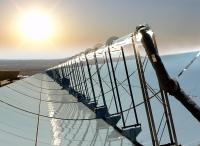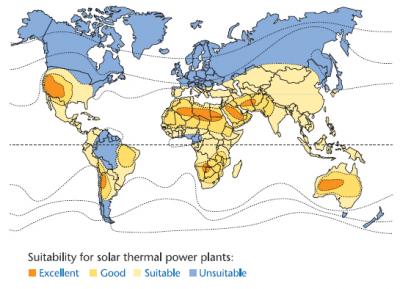 About two months ago I attended the opening of the largest “bright field” in America. While there I got the chance to meet with some representatives of SCHOTT solar the providers of the solar panels used in the field. This in turn lead to a tour of the solar cell plant. While there I started speaking with one of their representatives about solar thermal electricity.
About two months ago I attended the opening of the largest “bright field” in America. While there I got the chance to meet with some representatives of SCHOTT solar the providers of the solar panels used in the field. This in turn lead to a tour of the solar cell plant. While there I started speaking with one of their representatives about solar thermal electricity.
I got the chance to ask there CEO’s some questions about their Solar Thermal Electricity production plans. SCHOTT has been providing key components for parabolic trough collectors to collect heat and in turn produce large amounts of electricity for years now. Simple and elegant solar thermal electric generation has been an important energy production method. It will only grow in scale as people turn to renewable methods to create energy.
What follows is part two of three of the Answers they gave me. Read part one here.
5. How do you think these collectors could have an impact on some of the world’s poorest countries (which have some of the best solar resources)?
a. Specifically will they be in the price range of very poor African and Central/South American countries?
b. If they are, would these technologies be able to provide a significant amount of these countries energy needs?
The most likely immediate impact of solar thermal parabolic trough power plants upon the developing world would be on countries located in North Africa. These countries are located in an area that offers ideal conditions for the solar thermal parabolic trough power plants.
However, the power produced at these plants would probably be sold to countries in Europe, which produce more carbon emissions, and are therefore under more pressure to reduce their carbon emissions than North African countries.
The energy from such solar thermal power plants could be transmitted to Europe via high-voltage DC transmission lines.
The construction and maintenance of the solar thermal power plants and high-voltage DC transmission lines would provide jobs and other economic benefits to these countries.
6. How long does it take to build one of these power plants?
a. How does construction time compare to traditional power plants?
b. How does construction time compare to a wind farm or large PV array?
The time to build a solar thermal parabolic trough power plant varies depending on its size, the location it is being built, and other factors.
However, large solar thermal parabolic trough plants can be built relatively quickly. For example, construction of Nevada Solar One, a 64 MW solar thermal power plant, began in February of 2006 and is currently scheduled to be completed in the second quarter of 2007.
This timing compares favorably with the construction times for traditional power plants, wind farms and large PV arrays.
7. What are the environmental impacts of building one of these plants in a desert are the local eco-systems effected negatively?
Current data shows that solar thermal parabolic trough power plants have a minimal environmental impact on local eco-systems.
SCHOTT has not conducted any studies on the environmental impact of solar thermal power plants on the surrounding ecosystems. However, SCHOTT knows of no significant disadvantageous effects caused by the operation of the California SEGs over their 20 years of existence.
In addition, Greenpeace’s September 2005 report “Concentrated Solar Power Now!†(pdf) states that “A major benefit of solar thermal power is that it has little adverse environmental impact, with none of the polluting emissions or safety concerns associated with conventional generation technologies. There is hardly any pollution in the form of exhaust fumes or noise during operation. Decommissioning a system is not problematic.â€
In addition, parabolic trough technology has the lowest material requirements of all solar thermal technology. [7]
Land use of solar thermal power plants is substantially lower than biomass, wind energy or water power. In addition, since they are erected only in dry zones of the Earth, there is hardy any competition for land utilization. [8]
[7] SCHOTT White Paper on Solar Thermal Power Plant Technology, p. 13
[8] SCHOTT White Paper on Solar Thermal Power Plant Technology, p. 13
Download the entire white paper here (pdf).

please am a student and assignment was given to me on how to construct a local solar power in your house.